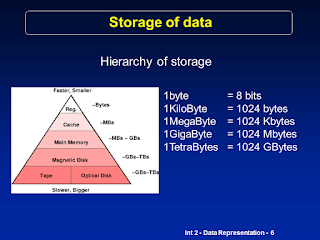DATA REPRESENTATION :
Internally the basic building block for digital computers is BIT.
What is Bit ?
Bit is a binary digit .they are 1 and 0 .
Relation Between Bits & Bytes :
nibble = 4 bits
bytes = 2 nibble or 8 bits
1KB (KiloByte) = 1024 bytes
1MB(MegaByte) = 1024 KB
1 GB(GigaByte) = 1024 MB
1TB(TeraByte) = 1024 GB
1PB(PetaByte) = 1024 TB
1EB(ExaByte) = 1024 PB
1ZB(ZettaByte) = 1024EB
1YB(YottaByte) = 1024 ZB
1 BB(BrontaByte) = 1024 YB
1 GB(GeopByte) = 1024 BB
Normally a single charecter/number/element is represented in term of one or more bytes.
COMPLEMENTS :
We are already dealt with possitive binary numbers. However computer not only handles possitive binary numbers but also negative once.There are three method to represents the negative numbers-
(1)Sign magnitude representation
(2)1's (ones) compliments representation
(3)2's (seconds)compliments representation
Sign Magnitude representation :
1 in sign bit represents the negative numbers
0 in sign bit represents the possitive numbers
Representation of +4 & -4
1's (ones)Complement Representation :
ones complement representation of number in binary is actually result of subtracting one from consecutive one's.
ones complement of 7 in 4 bit representation
1111-0111=1000
or simply inverting 0 to 1
0111---->1000
The prime disadvantage of ones complements that it has two representation of zero
2'S Complements Presentation :
Two's complement is a mathematical operation on binary numbers, and is an example of a radix complement. It is used in computing as a method of signed number representation.
The two's complement of an N-bit number is defined as its complement with respect to 2N; the sum of a number and its two's complement is 2N. For instance, for the three-bit number 010, the two's complement is 110, because 010 + 110 = 8 which is equal to 23. The two's complement is calculated by inverting the digits and adding one.
| Decimal value | Two's-complement representation |
|---|---|
| 0 | 000 |
| 1 | 001 |
| 2 | 010 |
| 3 | 011 |
| −4 | 100 |
| −3 | 101 |
| −2 | 110 |
| −1 | 111 |
| Decimal value | Two's-complement representation |
|---|---|
| 0 | 0000 0000 |
| 1 | 0000 0001 |
| 2 | 0000 0010 |
| 126 | 0111 1110 |
| 127 | 0111 1111 |
| −128 | 1000 0000 |
| −127 | 1000 0001 |
| −126 | 1000 0010 |
| −2 | 1111 1110 |
| −1 | 1111 1111 |
Two's complement is the most common method of representing signed integers on computers,[1] and more generally, fixed point binary values. In this scheme, if the binary number 0102 encodes the signed integer 210, then its two's complement, 1102, encodes the inverse: −210. In other words, to reverse the sign of most integers (all but one of them) in this scheme, you can take the two's complement of its binary representation. The tables at right illustrate this property.
Compared to other systems for representing signed numbers (e.g., ones' complement), two's complement has the advantage that the fundamental arithmetic operations of addition, subtraction, and multiplication are identical to those for unsigned binary numbers (as long as the inputs are represented in the same number of bits as the output, and any overflow beyond those bits is discarded from the result). This property makes the system simpler to implement, especially for higher-precision arithmetic. Unlike ones' complement systems, two's complement has no representation for negative zero, and thus does not suffer from its associated difficulties.







0 Comments
HAVE YOU ANY QUEERY,LET ME KNOW !